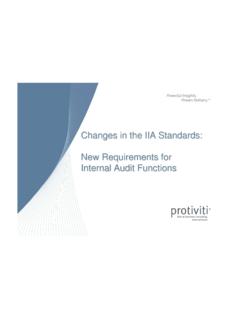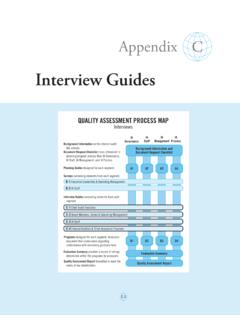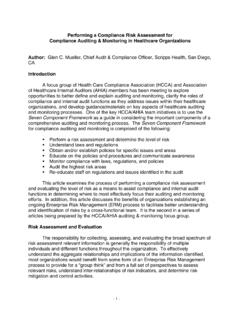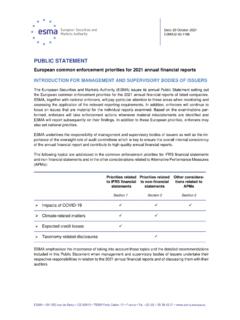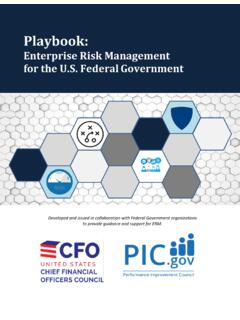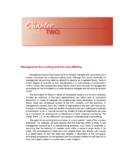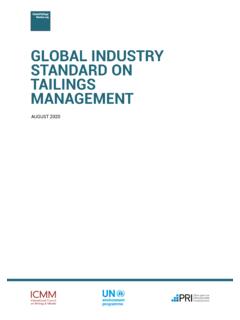Transcription of Auditing Credit Risk Management - IIA
1 Auditing Credit Risk Management Auditing Credit Risk Management About the IPPF The International Professional Practices framework (IPPF ) is the conceptual framework that organizes authoritative guidance promulgated by The IIA for internal audit professionals worldwide. Mandatory Guidance is developed following an established due diligence process, which includes a period of public exposure for stakeholder input. The mandatory elements of the IPPF are: Core Principles for the Professional Practice of Internal Auditing . Definition of Internal Auditing . Code of Ethics. International Standards for the Professional Practice of Internal Auditing . Recommended Guidance includes Implementation and Supplemental Guidance. Implementation Guidance is designed to help internal auditors understand how to apply and conform with the requirements of Mandatory Guidance.
2 About Supplemental Guidance Supplemental Guidance provides additional information, advice, and best practices for providing internal audit services. It supports the Standards by addressing topical areas and sector-specific issues in more detail than Implementation Guidance and is endorsed by The IIA through formal review and approval processes. Practice Guides Practice Guides, a type of Supplemental Guidance, provide detailed approaches, step-by-step processes, and examples intended to support all internal auditors. Select Practice Guides focus on: Financial Services. Public Sector. Information Technology (GTAG ). For an overview of authoritative guidance materials provided by The IIA, please visit 1 Auditing Credit Risk Management Table of Contents Executive Summary .. 2 Introduction .. 2 Business Significance: risks and Opportunities.
3 3 Key Credit Risk-related Regulations .. 6 Credit Risk Governance .. 12 Credit Risk 14 The Role of Internal Audit .. 16 Change Management .. 17 Planning and Performing the Engagement .. 18 Gather Information .. 18 Risk Assessment .. 19 Planning the Engagement .. 20 Performing the Engagement .. 22 Reporting .. 29 Appendix A. Relevant IIA Standards and Guidance .. 30 Appendix B. Glossary .. 31 Appendix C. Acronym Guide .. 33 Appendix D. Sample Credit risks .. 34 Appendix E. References, Additional Reading, Permissions .. 35 Acknowledgements .. 38 2 Auditing Credit Risk Management Executive Summary Credit risk has always been considered a key risk for financial services organizations and, for a good number of organizations, maybe the most critical risk. After the global financial crisis, regulators and supervisors focused on this risk, emphasizing the necessity of having accurate models that can measure the capital impact of Credit activities, the risk of leveraged finance, and the great importance of counterparty risk.
4 These new requirements and supervisors expanded expectations are giving internal audit a more relevant and active role in the assessment of Credit risk. In addition, an organization s board of directors has direct responsibility on the Credit risk oversight and governance, so internal audit should give independent assurance per their Mission, Core Principles, and Standards (as contained in the 2017 IPPF) to the appropriate governance body. The purpose of this guidance is to provide internal auditors with a baseline skill set that allows them to test and evaluate the effectiveness of the organization s Credit risk Management framework and processes. Introduction This guide provides support to internal auditors in the financial services sector with Auditing Credit risk. Credit risk is one of the essential risk categories of the financial services sector.
5 Regulators across the globe are focused on financial services organizations Credit risk Management activities. Moreover, regulators and supervisors consider managing the Credit risk one of the pillars required to maintain a robust and solvent financial sector, which in turn encourages a steady economic condition. Given the complexity and importance of managing Credit risk within a financial services organization, this guidance will focus on Credit risk arising from a financial services firm s lending practices. Further guidance will address more complex topics such as derivatives, hybrid investment portfolios, options, and other structured securities. After reading this guidance, internal auditors should be able to: Understand the importance of Credit risk in a financial services context. Understand the regulatory environment and requirements related to Credit risk.
6 Understand the governance and risk Management processes surrounding Credit risk. Describe the nature and basis of measurement of the probability of default. Note: Terms in bold are defined in the glossary in Appendix B. In addition, acronyms used in this guide are spelled out in Appendix C. 3 Auditing Credit Risk Management Design an audit engagement that assesses the appropriateness and effectiveness of the Credit risk Management framework and the adequacy of the institution s Credit profile. Be able to apply IPPF and risk-based internal audit techniques to assess and audit Credit risk in their organization. Business Significance: risks and Opportunities To properly manage the risks facing their organization, employees must understand the terminology associated with risk Management , compliance, and internal Auditing . One tool to communicate risk information across an organization is a risk framework .
7 The IIA s Financial Services Guidance Committee has developed a comprehensive risk framework specifically for financial services organizations. This risk framework , depicted in Figure 1, considers the major areas of risk applicable to the financial services industry on a global basis. Models Compliance Liquidity Capital Credit and Market Insurance Operational Asset / Liability Matching Culture and Conduct Strategic Reputational Source: The Institute of Internal Auditors. Figure 1: The IIA s Financial Services Risk framework Counterparty & IRR 4 Auditing Credit Risk Management The definition of Credit and Counterparty Risk is the potential that a financial organization, borrower, or counterparty will fail to meet its obligations in accordance with agreed terms. 1 (For definitions of each element of The IIA s Financial Services Risk framework , please see IIA Practice Guide, Foundations of Internal Auditing in Financial Services Firms.)
8 The basic concept of Credit and counterparty risk is fairly straightforward: each year a certain percentage of borrowers and counterparties will default. If the Probability of Default (PD) forecast is lower than the realized default rates, the organization will have additional write-offs, so it is important that the financial services organization generates reasonable and stressed forecasts of their PD risks . These write-offs may be offset by amounts collected during the organization s collections and recovery processes, so the PD forecast data feeds into forecasting of the expected Loss Given Default (LGD). Multiplying the PD and the LGD results in the total Expected Loss (EL) for the time period. If the realized loss is larger than the EL, the return on equity (ROE) will be less than the amount forecasted by Management . If the realized loss is smaller than the EL, the ROE will be more than forecasted by Management .
9 The EL can be calculated as a percentage (EL = PD*LGD) or it can be calculated in terms of money by multiplying PD, LGD, and the Exposure at Default (EAD). The dollar amount of EAD becomes concrete when calculating the value of an asset at the point of default or over time. Further, EL can be affected by fluctuations in Credit lines. This concept is referred to as the Credit Conversion Factor (CCF). The CCF applies primarily to Credit cards or similar loans and Credit lines where there is a finite value, but obligors are not paying in regular installments as the balance changes. This makes it impossible to know what will happen within the account over time as the obligor may withdraw funds from the available Credit line. If the account goes into default, how can EAD be accurately measured if the amount the obligor owes is unknown? The CCF requires the institution to analyze the obligor s behaviors using historical data to estimate how much of their exposure will convert into losses at the time of default.
10 The EL calculation becomes: EL = (Withdrawn amount + CCF * unwithdrawn amount) * LGD * PD A key element in the EL equation is LGD. LGD tools ( , appraisals, blue book values, resale stats, stock prices, futures) are used to assess the value and/or the quality of an asset the organization holds in exchange for providing funds. Collateral can be hard assets such as cars and machinery, mortgages, commodities, or any number of other assets. The higher the value of the security, the lower the LGD and the lower the EL. 1. Principles for the Management of Credit Risk, Basel Committee on Banking Supervision, September 2000, 5 Auditing Credit Risk Management As shown in Figure 2, unexpected losses produced by Credit portfolios are covered up to a confidence level of by the capital. The confidence level will be set by the relevant regulator and/or Basel standards.



